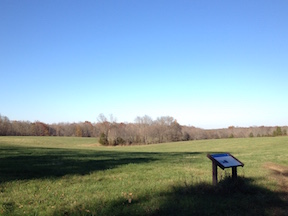Payne’s Farm After Dark

November 27 marks the anniversary of the 1863 battle of Payne’s Farm, part of the Mine Run campaign. Elements of the Army of the Potomac and Army of Northern Virginia, converging toward a wayside in the Virginia Wilderness known as Robinson’s Tavern along the Orange Plank Road, stumbled into each other. The ensuing fight, known as the battle of Payne’s Farm, was “was one of the sharpest engagements of the war, and was strongly contested by both sides,” said Edwin L. Wage of the 151st New York.
Maj. Gen. Edward “Allegheny” Johnson’s single division threw itself into the Union Third and Sixth Corps, bottlenecked along the Jacob’s Ford Road. Federals enjoyed a 3-to-1 advantage on the battlefield—6-to-1 factoring in the stymied Sixth Corps—but the Federals nonetheless came off worse for the wear, with 943 casualties compared to 545 Confederates killed, wounded, and missing. Fighting “ceased only when it became too dark to see,” Wage wrote. “Neither could claim a victory.”
Johnson withdrew to join up with the main body of Lee’s army, leaving behind a battlefield strewn with arms, with artillery and infantry ammunition, his dead and dying.” It was into that no-man’s land that Wage, who volunteered to search for wounded comrades, made his way….
“As night came on our regiment was withdrawn a short distance to the rear,” Wage wrote:
“A roll call was had by companies. Many comrades who went into the battle failed to respond to their names. At this time the enemy was still actively shelling the woods where we were. As the roll call of Co. I was going on, a shell struck the ground a few feet in front of our line, bounded, passed over our heads, buried itself in rear of the line and exploded without doing harm.
“After roll call volunteers were called for, to go over the field of battle between the lines, to find the wounded and remove them to the rear, where they could secure surgical treatment. The writer was one of a number of men who volunteered.
“There was a moon, but it was obscured a part of the time. We went onto the field between the picket lines, (who were frequently firing) in single file, without arms, and made as little noise as possible so as to not draw the fire of either side. When a wounded soldier was found two or three men would assist him to the rear. I can never forget the experience of that night. Dead men lying in all positions, in some places two or three close together. One soldier was lying on his back still grasping his Enfield rifle in his right hand, the left extended holding the rod as he was in the act of loading. A shell had struck his head.
“I received a bad scare that night, and for a time thought I was sure to be taken prisoner. I had gone beyond the rebel picket and was inside their lines. With great caution I gradually worked my way back, guided by the picket firing. I never knew how long I was getting back, and shall never forget the sensations I felt at that time, and how glad I was when I reached our own lines.”
I would love it, Chris, if he would also talk about the cavalry operations in this campaign.
Battle was an excellent demonstration of the quality of mid level leadership Meade was left with after Gettysburg. A refutation for those who believe Meade underplayed his hand in the weeks immediately after that battle.
John–Meade AFTER Gettysburg is a subject that never gets old for me. Easy to criticize, but most of today’s reenactors are almost too tired to drive home after a mere weekend of “playing army.” And don’t start about weather. Thanks for pointing this out–nice work, Chris.
Thanks, Meg.
I continue to go down the Mine Run rabbit-hole. What an incredible undiscovered battlefield experience & waiting to happen preservation opportunity. The Payne’s Farm acquisition by the American Battlefield Trust over a decade ago was a big win. Moving forward into a new decade…perhaps we can add more preserved ground to the Mine Run battlefield? Perhaps the abandoned house location with preserved works? Or the Rows Mill location on the Mine Run along the CS line where it meets the Orange Turnpike? Or even the Locust Grove corner catty-corner to the Robinson’s Tavern (Exxon) location? I will continue to look for new preservation opportunities there and hopefully it’s on the Central Virginia Battlefield Trust’s radar.
What a brave man. I appreciated hearing his “voice.”